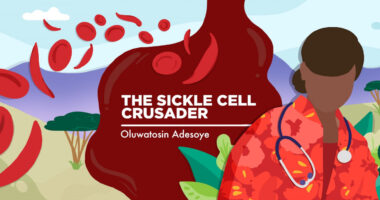Redefining what sickle cell disease warriors look like
Challenging misconceptions about patients' appearances

Growing up, health professionals and others often told me I didn’t look like a sickle cell patient. Their remarks left me wondering what was so unusual about my appearance and what I was expected to look like as someone living with sickle cell disease.
One vivid memory from my childhood revolves around my second hospital admission at the age of 11. During the ward round, doctors and student doctors engaged in a lengthy discussion for more than a half-hour, attempting to decipher why I didn’t exhibit the expected physical traits of a sickle cell warrior. Their responses varied, ranging from my diet to my parents’ socioeconomic and educational status, to medication compliance, and many more. Despite the extensive debate, they couldn’t reach a definitive conclusion.
Throughout my childhood, I repeatedly heard remarks such as “She doesn’t look like a sickler” during doctor appointments, which further fueled my uncertainty about the anticipated appearance of a sickle cell patient.
Sickle cell habitus
My understanding of this matter evolved during my medical studies, as I learned about the habitus of sickle cell disease, or the physical features commonly observed in patients. These characteristics include skull bossing, jaundice, pallor, protruded abdomen, thin limbs, stunted growth, barrel chest, leg ulcers, bone deformities, and more. These physical attributes result from the disease’s pathophysiology, manifesting as its associated symptoms and complications.
During my time as a medical student and later as a doctor, I encountered many colleagues who prided themselves on being able to identify a sickle cell patient on sight. I, too, initially subscribed to this notion — until I delved deeper into the complexities of sickle cell disease, and my experiences challenged that belief.
Challenging preconceptions and misconceptions
As time passed, I encountered sickle cell patients who did not exhibit the typical physical traits associated with the condition. Crucially, my involvement in sickle cell support groups revealed the fallacy of some of my previous beliefs. It became evident that sickle cell disease isn’t always visible, as many health professionals assume, and that individuals may not outwardly appear to be sickle cell patients unless they explicitly disclose their condition.
Engaging with these support groups exposed me to warriors of diverse appearances — sickle cell patients who were obese, lacked jaundice, had a flat tummy with no bone deformities, and many more, while some exhibited the typical habitus.
As I went deeper into the study of the disease and even ventured into sickle cell research, I uncovered many enlightening facts. As much as there is a recognized sickle cell habitus, it is not universally applicable. Also, sickle cell disease affects individuals in diverse ways due to factors that may not always be within our control.
Another prevalent misconception among healthcare professionals is the belief that people who don’t exhibit the typical sickle cell habitus or who are obese rather than slender have a milder form of the disease. This misguided belief often leads to inadequate pain management in these patients, as they are erroneously perceived to be malingering due to their atypical appearance as sickle cell patients.
My personal experiences have revealed the fallacy of using physical features to gauge the severity of sickle cell disease. I have encountered patients with more pronounced physical features of sickle cell than myself, yet they have a milder disease. Conversely, I have met sickle cell warriors with no apparent physical features who experience more severe manifestations of the condition. It is unequivocally wrong for healthcare professionals to utilize physical appearance as a sole determinant of disease severity.
Embracing diversity
Telling someone they don’t look like a sickle cell patient is a misguided remark because it stems from a flawed assessment of what a sickle cell patient looks like. Sickle cell warriors can come in various heights, body types, and sizes. This diversity does not diminish their status as a warrior. It is imperative to dispel the ignorant assumptions of some health professionals that all sickle cell patients fit a stereotypical mold. Sickle cell disease can be visible in some individuals and invisible in others.
Did you find this column informative? Please share your thoughts in the comments below.
Note: Sickle Cell Disease News is strictly a news and information website about the disease. It does not provide medical advice, diagnosis, or treatment. This content is not intended to be a substitute for professional medical advice, diagnosis, or treatment. Always seek the advice of your physician or other qualified health provider with any questions you may have regarding a medical condition. Never disregard professional medical advice or delay in seeking it because of something you have read on this website. The opinions expressed in this column are not those of Sickle Cell Disease News or its parent company, Bionews, and are intended to spark discussion about issues pertaining to sickle cell disease.






Heritage
Thanks mama💖💖 i hope medical professionals do this and manage those of us, that don't have the physical visible well.
Victoria Olaoye
This column was really helpful. Thank you so much.
All my life, I have always heard medical professionals say that I don't really look like a sickle cell until they take closer look at my eyes. It's unfair neause they implanted that in my parents when I was little. So growing up and falling sick constantly, my parents were like I was the cause that they were told that the traits isn't too much in me and that it will leave in due time. But mama,I have lived 22 years of my life as a sickle cell and also I just let the hospital last week..